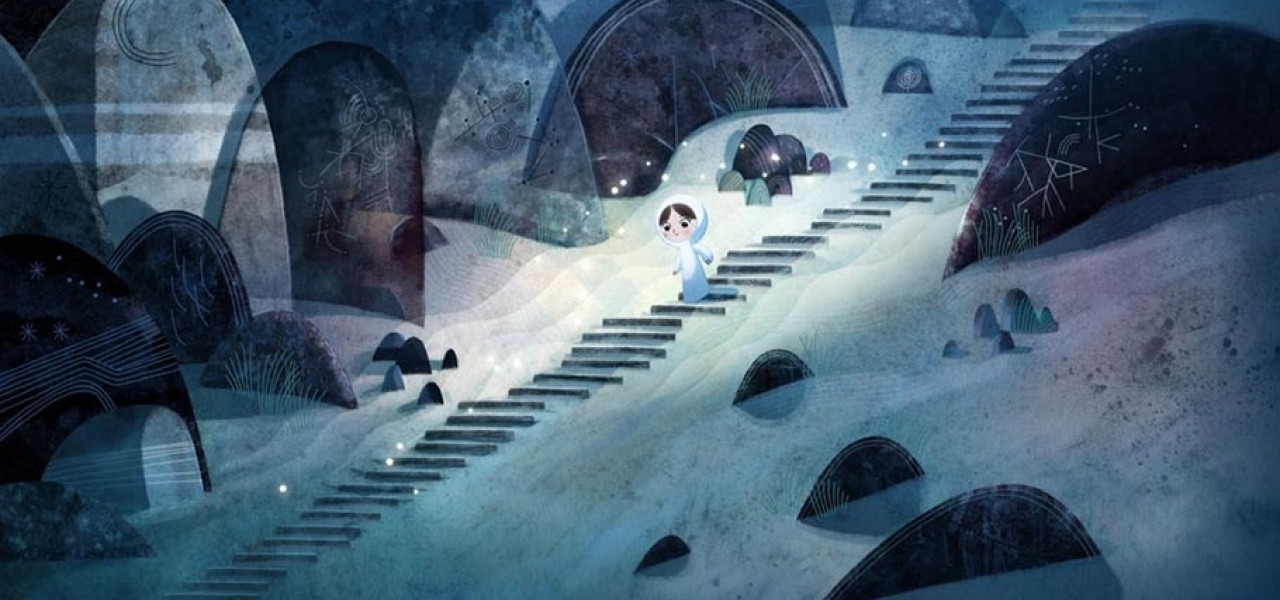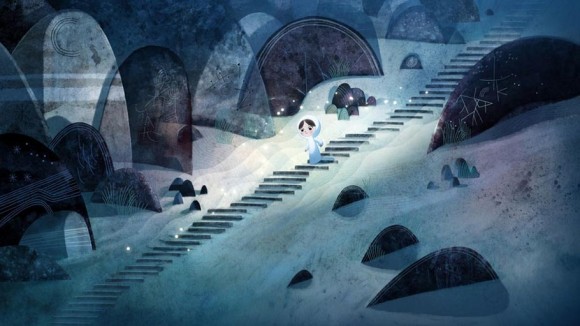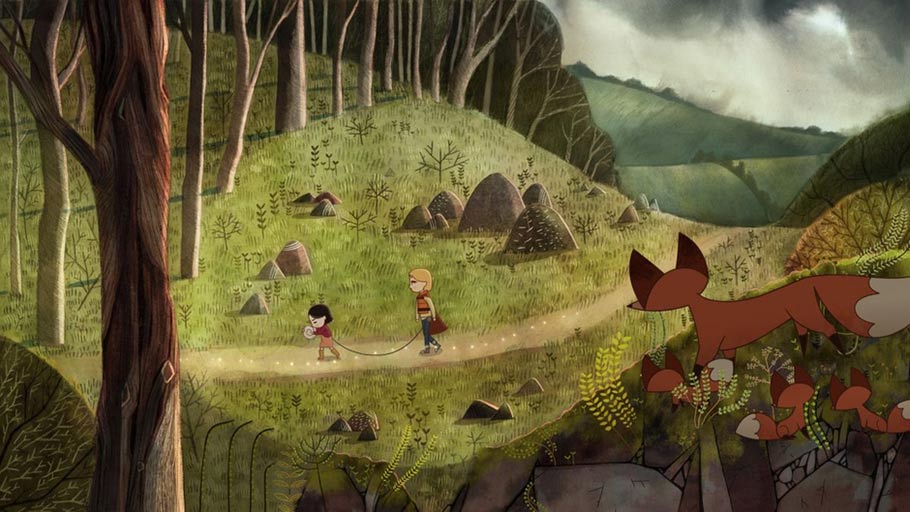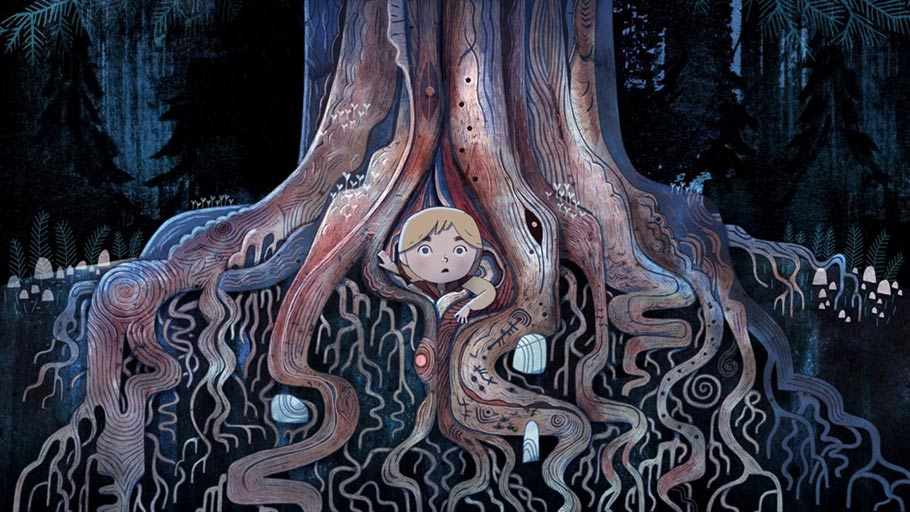

Tomm Moore on ‘Song of the Sea,’ Reinventing 2D, and Dodging the Studio System
He has yet to hit his fourth decade on the destabilized Earth to which his films are (re)connecting us, but Ireland-born Tomm Moore is nevertheless piling up the powerful visual experiences.

Like his Oscar-nominated feature debut The Secret of Kells, his new stunner Song of the Sea is steeped in regional folklore but still a universal wonder. But it is a more personal epic, about the extinction of mythological seal people called Selkies, as explored through a lighthouse family riven by loss and misunderstanding but healed by history and magic. Like its acclaimed forebear, the proudly hand-drawn Song of the Sea is also a mythic journey led by children, as they walk the tightrope between the belief systems that knit them to the planet (and thus each other), and a postmodern future that severs them into solitude.
“Without folklore, there isn’t the same respect,” Moore told me by phone during a visit to New York, explaining Song of the Sea’s selkie birth in a real-life seal slaughter, by the hands of infuriated humans. “So I wondered if there was a way to reinforce the truth of that folklore without people having to literally believe in it anymore.”
Moore and his indie Cartoon Saloon compatriots set about incorporating selkie and other Irish storyteller (seanchaí) folklore and iconography to piece together Song of the Sea’s 2D splendor, which visually trips from sea gods and stone fairies to Sony Walkmans and city streets without sacrificing cohesion or impact.
Cartoon Saloon’s next feature is an adaptation of Deborah Ellis’s debut novel The Breadwinner, about a girl struggling to hide her identity and feed her family under the oppression of Afghanistan’s reactionary Taliban. Helmed by Secret of Kells’ co-director Nora Twomey, Moore said the Saloon’s iteration of The Breadwinner is “trying to involve two styles again, one based on traditional Afghan art and 2D animation that represents the real world of Afghanistan,” circa war-torn 2001.
I spoke with Moore about Song of the Sea, the legacy of Studio Ghibli (which, like Moore, is angling for an Oscar nomination for its most recent film The Tale of the Princess Kaguya), the lessons of Richard Williams, reinventing 2D, and how and why we are losing our connection to the planet because we find it too hard to unplug from our Me Magazines.
Cartoon Brew: I asked my daughter what she wanted me to ask you, and she answered, “Why is Song of the Sea the only movie that makes me cry?”
Tomm Moore: I hope that’s a good thing that we made her cry, more bittersweet rather than upsetting.
Cartoon Brew: That’s what I mean: Your new film packs quite an emotional punch, for viewers of all ages.
Tomm Moore: That’s one thing I really wanted it to do. I’m really impressed when a film, a cartoon in particular, can have that effect. That was part of our challenge, focusing on these sad selkie stories but still trying to make them part of a palatable family feature film. So I’m glad the emotional impact didn’t go away. When you work on these films for a long time, you’re never sure whether they are going to work or not.
Cartoon Brew: Connectedness is a major theme, between humans, between animals and humans, between the natural and developed world, between myth and reality.
Tomm Moore: It was an organic process. I felt it important to reinforce that losing folklore from our everyday life means losing connection to our environment and culture. In Ireland, during the Celtic Tiger years, we were losing touch so I wanted to speak about it. In terms of visuals, it was a case of trying to match inspiration from old carvings and rock art with the touchstones of modern life. Especially in Ireland, where everything overlaps. You can be in a forest but still find an old television, rotting away.

Cartoon Brew: Speaking of severed environmental and cultural connections, Song of the Sea was inspired by a real-life seal slaughter?
Tomm Moore: On holiday with my son, in the west of Ireland. We were sketching on the beach; it was pretty horrible. When we asked why there were so many dead seals on the beach, our landlady said local fisherman were killing them out of frustration with falling fishery stocks. She said it wouldn’t have happened years ago, when there was a belief system that deemed seals sacred because they were the souls of people lost at sea, or actual selkies. That started me thinking that folklore and superstitions serve functions beyond entertainment, or quaint stories for tourists. They bind people to the landscape, and that is being lost.
Cartoon Brew: Although it reaches back, Song of the Sea is powerful cli-fi of its time, one of catastrophic global warming.
Tomm Moore: We live in little bubbles, and we’re able now to ignore it. But it’s not until water is lapping around our feet that we’re going to believe it is happening. We all read our Facebook feeds, I’m as guilty of it as anyone, but it’s like a Me Magazine. We’ve whittled the world down to the few things we are interested in seeing, which are selected especially for us by algorithms, so we don’t have to face anything too harsh. And that bubble is especially pervasive amongst kids. I see my son growing up immersed in technology that was just arriving as I was growing up, and I see how it shapes how we look at the world.
But as storytellers, we have opportunities to broaden the way people think about the world, and while we may not change anyone’s mind, we may hopefully be a part of the slow chipping away at indifference. People have been asking me if I want to make movies for adults. I don’t see why not, but I also don’t see making movies for adults as more important. In fact, I actually think making movies for kids is more important, because they shape you. I watch so many movies as an adult and forget about most of them instantly, but those I saw as a kid left a deep impression. So we have a huge responsibility when we make movies aimed at kids to say something they need to know, instead of just distracting them with fart jokes and talking animals. Hopefully, we say something that benefits them when we have the opportunity, whereas for adults we can make throwaway trash they can eat pizza to.
Cartoon Brew: Do you feel animation has an ability to express these complicated themes more capably than live-action, especially if you’re trying to reach all ages?
Tomm Moore: Yeah, definitely. I don’t think it works as well with realistic live-action or CG. Realistic CG for me gets into the territory of live-action; it uses the same language and characters are specifically somebody. If I watch a movie with Tom Cruise, I’m very aware it is Tom Cruise. But when I watch animated films—particularly Japanese films, where characters are simple and environments are lush—the characters are avatars you can project yourself into. They’re so simplified that they are not specific; they represent swaths of humanity. That is what’s special about animation: It can tell stories in ways that allow kids to project themselves into them in a more visceral way than a live-action movie. Live-action films can be oddly over there, whereas animated films, at least for me, can be immersive.
Cartoon Brew: Does that make hand-drawn, 2D style more powerful and risky, given so much is riding on its mode of expression?
Tomm Moore: Scott McCloud talks about this a bit in Understanding Comics, and it made an impression on me when I was a student. You can mask yourself in simple character design, really immerse yourself in the world. Think of a film like Grave of the Fireflies
, which would be practically intolerable in live-action. It would be so dark, but through animation [Isao] Takahata was able to bring us through that experience in a way we could handle.
Cartoon Brew: Speaking of Takahata, The Tale of the Princess Kaguya, like Song of the Sea, seems defiantly hand-drawn.
Tomm Moore: I’m glad I saw it on the big screen. I was inspired by how brave and expressive it was, how it used so much language of the line. It is unashamedly hand-drawn.
Cartoon Brew: Last year brought us perhaps our last Miyazaki film, and this year perhaps our last Takahata film. Any thoughts on the legacy of Studio Ghibli, to whom your work has been compared?
Tomm Moore: I’m flattered by that. I was lucky to attend the Governor’s Awards in Los Angeles, and I got to shake Miyazaki’s hand. I don’t normally smoke, but when I saw him having a cigarette I asked someone if I could borrow one just so I could have a cigarette with Miyazaki! I was coughing and spluttering, but at the same time I was just geeking out that I got to have a cigarette with him. It’s great that Studio Ghibli’s films have been discovered and appreciated in the West. They’re very much a part of Japan’s graphically literate culture; over there, films like Spirited Away can be bigger at the box office than Titanic or whatever. I wish we had that over here in the Anglosphere, but we don’t.
But I think today 2D animation has a responsibility, much like painters had after photography was invented, to reinvent what it is. It can’t go after realism, because there is no point; it has to do something only 2D can do. In painting, we got Expressionism, Impressionism, Cubism and other modern movements because of photography. The Tale of the Princess Kaguya and other Ghibli films point the way that 2D has to keep going to reinvent itself. In the whole history of visual arts, there is still so much that we can explore.

Cartoon Brew: It feels almost revolutionary today to find animated films that specifically call attention to themselves as animation, rather than replicating what they see in live-action cinema.
Tomm Moore: Exactly. At the moment, I think the big studios are almost in love with how much they can replicate live-action—although sometimes I think it’s cool and makes sense for a lot of their stories. A film that did it well, to a great extent, was How to Train Your Dragon 2, which had amazing cinematography and almost felt like a big Peter Jackson movie with cartoon characters. But I do think that animation can have a language of its own, rather than simply mimicking live action.
Cartoon Brew: Do you feel that the once-marked difference between what is considered animated and live-action film is holding up?
Tomm Moore: I’m not a CG animator or VFX guy, but I notice and appreciate that a blurring is happening. Who Framed Roger Rabbit was a revolutionary mix of animation and live-action, and most live-action movies, certainly the blockbusters, are 20-35 percent animation. But Avatar is basically an animated movie, or, even more surprising, Gravity, which didn’t have fantastic creatures or anything like that. It was largely animated, and even used the animated process of boarding, pre-viz, all that stuff. The paradigm of making movies has gone more toward the animation process than the other way around.
Cartoon Brew: Although your films are 2D, they still marvelously flow outward like 3D.
Tomm Moore: Thanks! I was really impressed by what Richard Williams said in documentaries I watched in college. He was quite resistant to computers back then, but when I met him a few years later he was impressed with the subtleties and nuances of performance that artists were able to achieve using them. So I’ve got a lot of love for computer animation, but I think it’s also important to have an alternative. It would be a pity for the tradition of hand-drawn animation to die out. Yet with technology, we’re offered the opportunity to make hand-drawn animation in a way that we weren’t even fifteen years ago. With today’s computers, we can make hand-drawn animation on a feature scale with much smaller teams and lower budgets, and still make it more personal than high-level CG, which still requires a lot of money, a lot of technology and a lot of people. Through technology, hand-drawn animation has actually become more accessible.

Cartoon Brew: If Song of the Sea follows The Secret of Kells to an Oscar nomination, or even a win, would the studios be able to entice you to make a blockbuster? Are you interested in that?
Tomm Moore: Not particularly. I thought about that more seriously around The Secret of Kells, and was particularly interested in some story departments, because I was impressed by how Pixar makes movies that appeal to massive audiences. But I got to be friends with some artists there who were saying, “Look, keep going, you’re going to learn more by making your own movies.” It’s tricky, because we’re always on a shoestring budget, but if I can keep making films outside of the system, I’m happy to. Any interest generated by a nomination for Song of the Sea will hopefully allow me to keep making more movies like it.
Cartoon Brew: Sounds sensible to me.
Tomm Moore: I interpreted it as that when we got the Oscar nomination for The Secret of Kells. It felt like my peers and colleagues in American animation were saying, “Great! Let’s see more of this!”—rather than, “Come over here and make The Smurfs!”

Cartoon Brew: Let’s rewind back to Richard Williams. I’m sure animators know who he is, but I feel the rest of the world still doesn’t.
Tomm Moore: It’s really a pity, isn’t it? He gave such gifts to animation during those dark days of cheap TV shows, and rescued greats like Ken Harris and Art Babbitt and sort of accumulated all their knowledge. I once met Roy Naisbitt, his art director/layout man and, funnily enough, also his studio administrator, which I could really relate to. I think there should be a statue built for Richard Williams somewhere. It’s interesting because while he never got to finish The Thief and the Cobbler, he did leave behind a legacy of teaching and understanding. He collected all that knowledge from the Golden Age and carried it forward. In animation circles, he inspired so many of us to see that animation could be an art form.
Cartoon Brew: His work is so fluid, and has such a velocity. I think of the chase scene in Thief where the Thief is chased through dizzying patterns…
Tomm Moore: Yeah, the references to Bridget Riley and Op Art blew me away. In documentaries, Williams said animation could do Rembrandt but just hasn’t yet, that the height of animation wasn’t Disney, that the height of animation hasn’t even been reached. Now that we are living in such a graphic and visual society—where animation is basically everywhere, including our phones—there’s an opportunity to do what Williams was talking about, and was struggling to do in a much more limited era.
Cartoon Brew: Well, I don’t want to put any pressure on you, but after The Secret of Kells and now Song of the Sea, students are going to be looking to you and asking you what you think.
Tomm Moore: Bizarre! What I really like about Richard Williams is that he never wanted to copy anyone. He wanted us to learn technique and technology, but he also wanted everyone to do their own thing. Even in his master classes, he’d say, “I’m just teaching you about this, so don’t copy me. Don’t be the Woody Woodpecker fan who just wants to remake Woody Woodpecker, again and again. Use the mechanics of animation to make something personal, in your own style.” That was what was so inspiring to us in Cartoon Saloon; we took Irish art and gave the world our take on it, but that isn’t to say that another Irish animator shouldn’t take the same thing and do something else. The fundamentals that Williams talks about may be the same, but the results should be different. That’s what I find most exciting, not copying each other but constantly reinventing ourselves, using the fundamentals.
Cartoon Brew: You seemed to have learned that lesson, because when people see your films they know they are yours.
Tomm Moore: Yeah, which is actually great, even in a strange, purely capitalist way of thinking about it. I think there’s value in that. It’s obviously not what we think about in the first place, but now we want to keep moving forward with it, and carve out a little space for ourselves.
This interview has been edited for length and clarity.

.png)